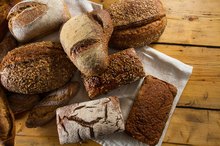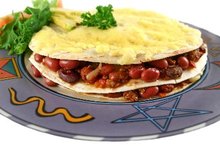What does fact checked mean?
At Healthfully, we strive to deliver objective content that is accurate and up-to-date. Our team periodically reviews articles in order to ensure content quality. The sources cited below consist of evidence from peer-reviewed journals, prominent medical organizations, academic associations, and government data.
- American Heart Association: Sugars and Carbohydrates
- Centers for Disease Control and Prevention: Vitamins and Minerals
The information contained on this site is for informational purposes only, and should not be used as a substitute for the advice of a professional health care provider. Please check with the appropriate physician regarding health questions and concerns. Although we strive to deliver accurate and up-to-date information, no guarantee to that effect is made.
Carbohydrates in Pita Bread
Pita is a pocket-shaped bread made from flour, water, salt and yeast 1. While the exact location and origination period of pita bread is unknown, it more than likely has Bedouin roots 1. The bread grew popular in the U.S. in the 1970s as Middle Eastern immigrants relocated to the West. Pita bread is generally very nutritious, containing all three macronutrients -- fat, protein and carbohydrate -- and a variety of vitamins and minerals 1. Pita bread is particularly high in carbohydrates 1. Pita bread can be used in place of regular bread 1. You can stuff it with your favorite sandwich and salad ingredients.
Total Carbohydrates
According to the USDA, pita bread made from white flour contains 55.7 grams of carbohydrates per 100 grams, while whole-wheat pita bread contains 55 grams 12. Carbohydrates contains 4 calories per 1 gram, so white and whole-wheat pita bread contain about 223 and 220 calories from carbohydrates, respectively 1. Most adults need about 900 to 1,300 calories, or 225 to 325 grams, of carbohydrates each day to meet their energy needs.
Fiber
Japanese Sweet Potato Nutrition
Learn More
Whole-wheat pita bread contains 7.4 grams of dietary fiber per 100 gram, while white pita bread contains 2.2 grams, according to the USDA Nutrient Database 12. Fiber is a complex carbohydrate specific to plants, and serves a number of important dietary functions. Insoluble fiber helps promote digestive health by clearing blockages as it passes through the intestinal tract, while soluble fiber helps to lower blood cholesterol and glucose levels. Dietary fiber may also help prevent certain types of cancer, according to the Physician's Committee for Responsible Medicine 4. Adult women and men should consume about 26 and 38 grams of fiber each day, respectively.
Sugars
Whole-wheat pita bread contains 0.82 grams of sugars per 100 grams, while white bread contains none, according to the USDA 12. Sugars are simple carbohydrates consisting of one or two saccharide molecules. These carbohydrates have a rapid and sharp impact on blood glucose levels, providing an immediate source of energy to your body's cells. While sugars are found naturally in plant foods, added sugars are extracted and used to increase the flavor of packaged and processed foods. These added sugars can be harmful and the American Heart Association recommends adult women and men limit their added sugar intake to 25 and 37.5 grams per day, respectively 3.
Additional Nutrition
Micro & Macro Nutrients in Bread
Learn More
Pita bread is fairly high in protein with both whole wheat and white pita bread containing over 9 grams of this macronutrient per 100 grams 1. Most adults need about 50 to 175 grams of protein each day. Pita bread is low in fat with under 3 grams per 100 grams, and free of cholesterol 1. Both whole wheat and white pita bread contain an abundance of vitamins and minerals 1. Whole wheat pita bread is particularly high in selenium, manganese, copper, zinc, niacin and thiamin, while white pita bread is high in niacin 1.
Related Articles
References
- MadeHow.com: Pita Bread
- USDA Nutrient Data Laboratory: Pita Bread, Whole Wheat
- American Heart Association: Sugars and Carbohydrates
- Physicians Committee for Responsible Medicine: How Fiber Helps Protect Against Cancer
- Mofidi A, Ferraro ZM, Stewart KA, et al. The acute impact of ingestion of sourdough and whole-grain breads on blood glucose, insulin, and incretins in overweight and obese men. J Nutr Metab. 2012;2012:184710. doi:10.1155/2012/184710
- Title 21. Food And Drugs. Subchapter B Food For Human Consumption. U.S. Food And Drug Administration Department Of Health And Human Services. Updated April 1 2019
- Najjar, AM, Parsons, PM, et al. "The acute impact of ingestion of breads of varying composition on blood glucose, insulin and incretins following first and second meals." Human and Clinical Nutrition. Vol. 101, No. 3 391-398 (2009).
- Najjar, AM. "The Impact of Breads of Varying Composition on Biomarkers of Glucose Metabolism in Overweight and Obese Adults." University of Guelph, December 2009
- USDA National Nutrient Database for Standard Reference, Release 21.
Writer Bio
Graham Ulmer began writing professionally in 2006 and has been published in the "Military Medicine" journal. He is a certified strength-and-conditioning specialist with the National Strength and Conditioning Association. Ulmer holds a Master of Science in exercise science from the University of Idaho and a Bachelor of Science in psychology from Washington State University.









